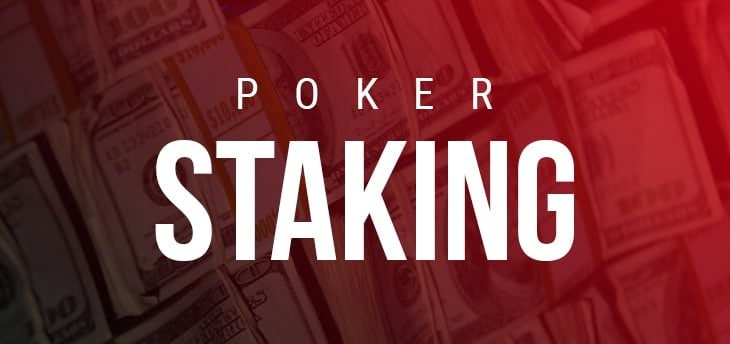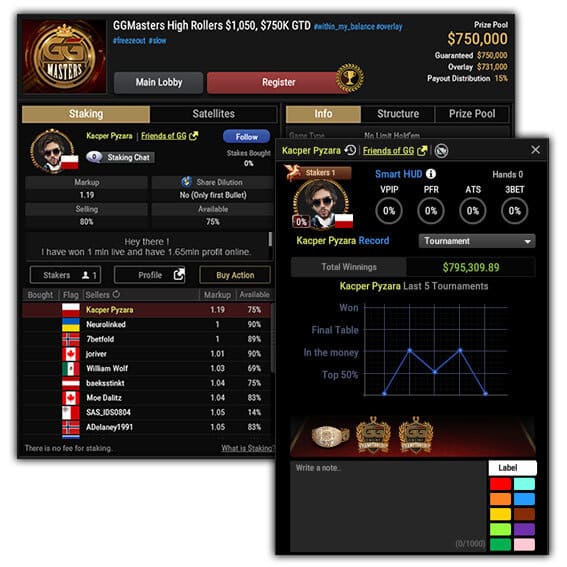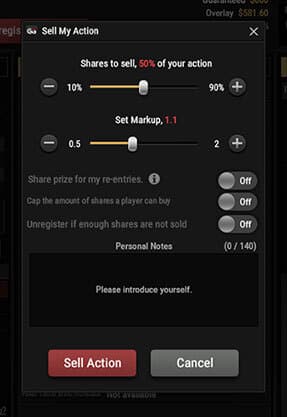The Beginners Guide Series: Introduction to Staking

In this article we will cover the ins and outs, the pros and cons, and the ‘anything else you might need to know’ about staking players through the GGPoker client. But the first thing you may want to know is ‘what is staking’?
Staking is a practice wherein two or more individuals enter into an agreement prior to a game of poker that has the people involved cover fractions of the cost to play for a proportional percentage of the winnings from the game of poker. Similar to an angel investor fronting the cost for a startup or existing company, but on a smaller scale and for poker. With GGPoker this process is automated through the staking client that can be found in the lobby of all eligible tournaments prior to their start.
Benefits and Drawbacks of Staking
When the cost of a tournament is more than a person is willing to or comfortable with paying, selling fractions of their action in the game can make it easier for that player. While this does reduce the players potential winnings, selling fractions of their action also reduces the losses. And when enough time is spent at the poker tables a bad run of cards is inevitable. You will eventually play games where every poker chip you commit to a pot will ultimately be collected by your opponent despite playing your best, it’s the nature of the game. A downswing, or constantly losing over a sample of games, can be devastating to your confidence, convictions in your ability, and bankroll if not properly managed. Selling action will insulate a player from many of these negative effects by providing a financial buffer. Additionally, from my own perspective, I feel like I can maintain a higher quality of play for a longer time and I take the game more seriously when I stand to lose other people’s money and not just my own.

The Math of Markup
While everyone who enters a game of poker has a chance to win, not all poker players are equal, nor are their chances of winning. As a natural development from this player inequality, a markup system has been adapted to account for the difference in skill levels. Players who are selling action will often sell at a premium, earning an additional percentage on each dollar invested. As an example, a player decides they want to sell 50% of their action in a $100 dollar tournament but want a markup of 1.2 or a 20% premium. This player is charging an additional 20 cents for every dollar of action sold, meaning stakers will receive $1 of value for every $1.2 invested. Selling action at a Markup can be a very effective additional layer of protection from the eventual downswings and overall variance of the game. Not only are you mitigating your risk by selling part of your tournament action (half in this example) but you are also getting a discount purchasing your own stake for the game. The player sold 50% of their $100 tournament for $60 (a markup of 1.2), netting a profit of $10 which is then deducted from the balance of the buy-in owing, the tournament will now cost the player only $40 and they play for a 50% share of the prize pool. Once these numbers are reviewed over a large sample, the math starts to become a very attractive proposition, particularly when you factor in the rakeback program and other player promotions.

Markup Strategies
Many players sell their action using a variety of sales tactics. While there is no definitive strategy on how to sell your action, there are some methods that generally work better. I have included some information based on my experiences to help you develop your own sales strategy.
The Freeroller:
Using a bit of math, it is possible to figure out how much of your stake to sell at what Mark Up in order to not have to pay anything to play in the tournament. You will have to sell a very large stake but you will be able to play the game for free. This strategy will work best for full time players who play a large volume of tournaments.
Pros: You cannot lose money if you stay disciplined. It is a very efficient way to move up stakes. You have the potential to earn high returns with rake back and promotions.
Cons: It can be hard to sell enough action to match the volume you need to play. The buy is going to be at a low Markup and high volume. Expect your quality of play to be lower due to higher table count
The Fish Out of Water:
This refers to a lower stakes player that finds themselves in a bigger buy-in tournament, usually through a satellite, where the buy-in is larger than their entire bankroll, and filled with players significantly more experienced. For these players, selling as much of the action as possible, even if it is at less than the cost, will help relieve the stress of cashing and allow the player to maximize their learning opportunity, while turning a portion of their ticket into real money.
Pros: Reduced stress due to already having made a profit. Playing for free against these more experienced players is a great learning experience.
Cons: If you do win the tournament, it will be less ‘life changing’ and more ’vacation time’

I’m Playing it Anyways:
You’ve already decided to play in the tournament and whether or not someone buys some of your action does not make a difference to you. The tournament is one you are comfortable with and you are planning for a ‘just in case’ situation. You can put out a piece of your action at a rate that makes it a gift if a player buys it. If you sell some of your action and freeroll part of the buy-in, great! If no one buys the action and you are playing just for yourself, also great!
Pros: It’s a win-win scenario for you as it does not matter if your action sells. If it does, you have some protection, if it doesn’t you keep all of your profits.
Cons: You forego all of the benefits of being staked and it could make you feel that you are not good enough for someone to stake you.
This is for Good Luck:
You avoid black cats, broken mirrors, and walking under ladders. You keep a rabbit’s foot, 4 leaf clover, and always wear the same shirt you wore when you won that 1 live tournament. You sell a small bit of action because you’re superstitious and altruistic. Maximizing markup is not much of a concern because there are greater unseen forces at work here.
Pros: You believe it lucky and it’s the right thing to do
Cons: If you run bad it could call your beliefs into question
The Influencer:
You are a streamer on Twitch, a YouTuber, and have a community of loyal followers. You might have even landed a cool promotional deal where your name appears purple in the lobby. Maybe you even have your own avatar. People tune in to watch you to play poker so you probably know what you’re doing, but all of this comes at a premium and that premium is your Markup
Pros: You can change a higher markup because of your status
Cons: Requires a successful stream and consistent results

